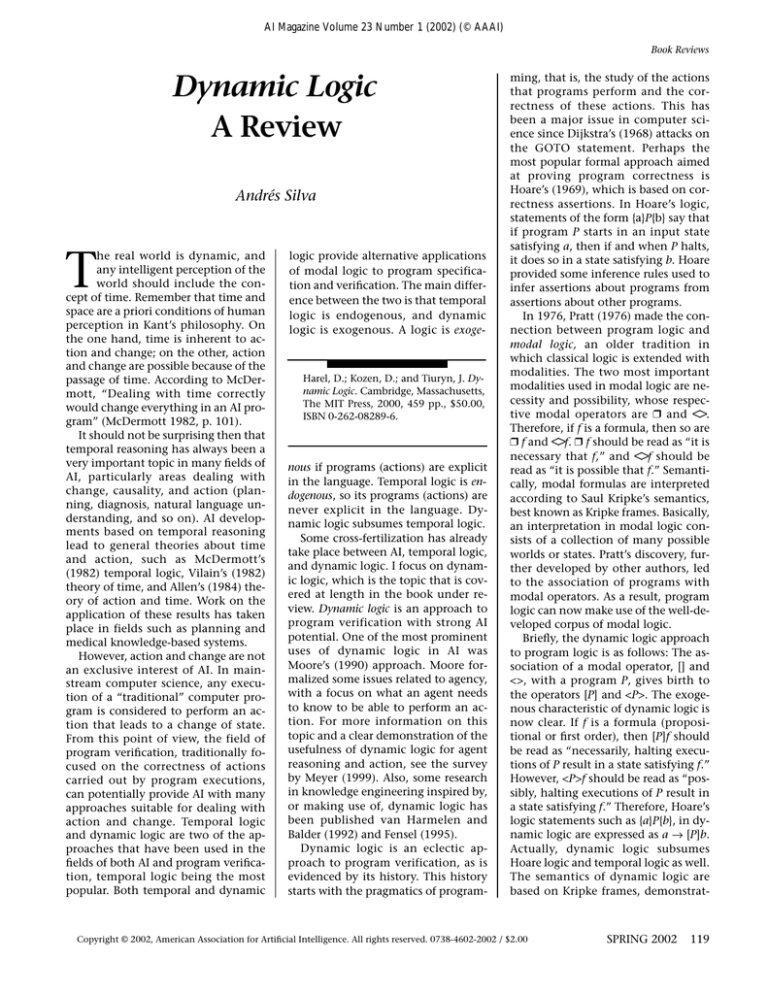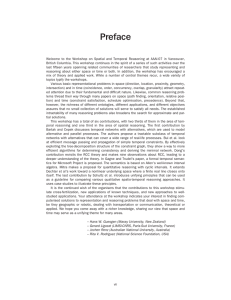
AI Magazine Volume 23 Number 1 (2002) (© AAAI)
Book Reviews
Dynamic Logic
A Review
Andrés Silva
T
he real world is dynamic, and
any intelligent perception of the
world should include the concept of time. Remember that time and
space are a priori conditions of human
perception in Kant’s philosophy. On
the one hand, time is inherent to action and change; on the other, action
and change are possible because of the
passage of time. According to McDermott, “Dealing with time correctly
would change everything in an AI program” (McDermott 1982, p. 101).
It should not be surprising then that
temporal reasoning has always been a
very important topic in many fields of
AI, particularly areas dealing with
change, causality, and action (planning, diagnosis, natural language understanding, and so on). AI developments based on temporal reasoning
lead to general theories about time
and action, such as McDermott’s
(1982) temporal logic, Vilain’s (1982)
theory of time, and Allen’s (1984) theory of action and time. Work on the
application of these results has taken
place in fields such as planning and
medical knowledge-based systems.
However, action and change are not
an exclusive interest of AI. In mainstream computer science, any execution of a “traditional” computer program is considered to perform an action that leads to a change of state.
From this point of view, the field of
program verification, traditionally focused on the correctness of actions
carried out by program executions,
can potentially provide AI with many
approaches suitable for dealing with
action and change. Temporal logic
and dynamic logic are two of the approaches that have been used in the
fields of both AI and program verification, temporal logic being the most
popular. Both temporal and dynamic
logic provide alternative applications
of modal logic to program specification and verification. The main difference between the two is that temporal
logic is endogenous, and dynamic
logic is exogenous. A logic is exoge-
Harel, D.; Kozen, D.; and Tiuryn, J. Dynamic Logic. Cambridge, Massachusetts,
The MIT Press, 2000, 459 pp., $50.00,
ISBN 0-262-08289-6.
nous if programs (actions) are explicit
in the language. Temporal logic is endogenous, so its programs (actions) are
never explicit in the language. Dynamic logic subsumes temporal logic.
Some cross-fertilization has already
take place between AI, temporal logic,
and dynamic logic. I focus on dynamic logic, which is the topic that is covered at length in the book under review. Dynamic logic is an approach to
program verification with strong AI
potential. One of the most prominent
uses of dynamic logic in AI was
Moore’s (1990) approach. Moore formalized some issues related to agency,
with a focus on what an agent needs
to know to be able to perform an action. For more information on this
topic and a clear demonstration of the
usefulness of dynamic logic for agent
reasoning and action, see the survey
by Meyer (1999). Also, some research
in knowledge engineering inspired by,
or making use of, dynamic logic has
been published van Harmelen and
Balder (1992) and Fensel (1995).
Dynamic logic is an eclectic approach to program verification, as is
evidenced by its history. This history
starts with the pragmatics of program-
ming, that is, the study of the actions
that programs perform and the correctness of these actions. This has
been a major issue in computer science since Dijkstra’s (1968) attacks on
the GOTO statement. Perhaps the
most popular formal approach aimed
at proving program correctness is
Hoare’s (1969), which is based on correctness assertions. In Hoare’s logic,
statements of the form {a}P{b} say that
if program P starts in an input state
satisfying a, then if and when P halts,
it does so in a state satisfying b. Hoare
provided some inference rules used to
infer assertions about programs from
assertions about other programs.
In 1976, Pratt (1976) made the connection between program logic and
modal logic, an older tradition in
which classical logic is extended with
modalities. The two most important
modalities used in modal logic are necessity and possibility, whose respective modal operators are ❒ and <>.
Therefore, if f is a formula, then so are
❒ f and <>f. ❒ f should be read as “it is
necessary that f,” and <>f should be
read as “it is possible that f.” Semantically, modal formulas are interpreted
according to Saul Kripke’s semantics,
best known as Kripke frames. Basically,
an interpretation in modal logic consists of a collection of many possible
worlds or states. Pratt’s discovery, further developed by other authors, led
to the association of programs with
modal operators. As a result, program
logic can now make use of the well-developed corpus of modal logic.
Briefly, the dynamic logic approach
to program logic is as follows: The association of a modal operator, [] and
<>, with a program P, gives birth to
the operators [P] and <P>. The exogenous characteristic of dynamic logic is
now clear. If f is a formula (propositional or first order), then [P]f should
be read as “necessarily, halting executions of P result in a state satisfying f.”
However, <P>f should be read as “possibly, halting executions of P result in
a state satisfying f.” Therefore, Hoare’s
logic statements such as {a}P{b}, in dynamic logic are expressed as a → [P]b.
Actually, dynamic logic subsumes
Hoare logic and temporal logic as well.
The semantics of dynamic logic are
based on Kripke frames, demonstrat-
Copyright © 2002, American Association for Artificial Intelligence. All rights reserved. 0738-4602-2002 / $2.00
SPRING 2002
119
Book Reviews
Network and Netplay:
Virtual Groups
on the Internet
application of dynamic logic to AI or
knowledge representation. However,
AI researchers who want to deepen
their understanding of the capabilities
and limits of dynamic logic will find
useful information in the book.
References
Edited by Fay Sudweeks,
Margaret McLaughlin and
Sheizaf Rafaeli
Foreword by Ronald Rice
The vast, international web of computer networks that is the internet offers millions of users
the opportunity to exchange electronic mail, photographs, and sound clips; to search
databases for books, CDs, cars, and term papers; to participate in real-time audio-and videoconferencing; and to shop for products both virtual and physical. This huge conglomerate
of links, hyperlinks, and virtual links is not just a technology for linking computers—it is
a medium for communication. The convergence of computer and communication technologies creates a social convergence as well. People meet in chat rooms and discussion
groups to converse on everything from automechanics to post-modern art; networked
groups form virtually and on-the-fly, as common interests dictate. Like interpersonal communication, the networks are participatory, their content made up by their audience. Like
mass-mediated communication, they involve large audiences. But the networks are neither purely interpersonal nor purely mass—they are a new phenomenon.
Network and Netplay addresses the mutual influences between information technology
and group information and development, to assess the impact of computer-mediated communications on both work and play. Areas discussed include the growth and features of the
internet, network norms and experiences, and the essential nature of network communications.
6 x 9, 320 pp. ISBN 0-262-69206-5
To order, call 800-356-0343 (US and Canada) or (617) 625-8569.
Distributed by The MIT Press, Cambridge, MA 02142
ing that dynamic logic is built on solid
modal logic foundations.
Here we have a book that provides a
deep insight into the topic of dynamic
logic. However, readers of this magazine should be warned: This book does
not provide tips on how to apply the
concepts of dynamic logic to AI because the main focus of the authors is
the use of dynamic logic as a formal
system for reasoning about programs.
This 460-page book is divided into
three parts: (1) fundamental concepts,
(2) propositional dynamic logic, and
(3) first-order dynamic logic. The first
part provides readers with the necessary background to understand dynamic logic and makes the book selfcontained. Despite the introductory
aim of this part, its contents are rather
deep, amounting to one-third of the
book. This first part covers mathematical preliminaries, computability, complexity, logic, and reasoning about
programs. Also, the authors provide
an introduction to other topics related
120
AI MAGAZINE
to dynamic logic, such as temporal
logic, process logic, and Kleene algebra
(but, strangely enough, these topics
are covered in the last chapter of the
book). The second part introduces
propositional dynamic logic, covering
syntax, semantics, properties, completeness, complexity, and so on. The
third part, on first-order dynamic logic, is the most involved part of the
book and introduces syntax and semantics, uninterpreted and interpreted levels, complexity, axiomatization,
expressive power of languages, and so
on.
This book is a comprehensive
source of information on dynamic logic. It is aimed at researchers, teachers,
and students of the subject. The book
can be used in a dynamic logic course
because all chapters come with exercises that teachers will find useful. If
you are interested in program logics
and program verification using dynamic logic, this is your book. Do not
expect to find any information on the
Allen, J. 1984. Toward a General Theory of
Action and Time. Artificial Intelligence
23:123–154.
Dijkstra, E. W. 1968. Go To Statement Considered Harmful. Communications of the
ACM 11(3): 147–148.
Fensel, D. 1995. The Knowledge-Based Acquisition and Representation Language KARL.
New York: Kluwer Academic.
Hoare, C. A. R. 1969. An Axiomatic Basis
for Computer Programming. Communications of the ACM 12(10): 576–580, 583.
McDermott, D. 1982. A Temporal Logic for
Reasoning about Processes and Plans. Cognitive Science 6(2): 101–155.
Meyer, J.-J.Ch. 1999. Dynamic Logic Reasoning about Actions and Agents. Paper
presented at the Workshop on Logic-Based
Artificial Intelligence, 14–16 June, Washington, D.C.
Moore, R. C. 1990. A Formal Theory of
Knowledge and Action. In Readings in Planning, eds. J. F. Allen, J. Hendler, and A. Tate,
480–519. San Francisco, Calif.: Morgan
Kaufmann.
Pratt, V. R. 1976. Semantical Considerations on Floyd-HCare Logic. In Proceedings
of the Seventeenth Symposium on the
Foundations of Computer Science, 109–
121. Washington, D.C.: IEEE Computer Society.
van Harmelen, F., and Balder, J. R. ML2: A
Formal Language for KADS Models of Expertise. Knowledge Acquisition 4(1): 127–167.
Vilain, M. 1982. A System for Reasoning
about Time. In Proceedings of the Second
National Conference on Artificial Intelligence, 197–201. Menlo Park, Calif.: American Association for Artificial Intelligence.
Andrés Silva is assistant professor at Universidad Politécnica de Madrid. He started
his research career at the Laboratory of Artifical Intelligence at Universidad Politécnica de Madrid and with the Group of Artificial Intelligence and Learning (GRAIL) at
Universidad Carlos III. In 1998 to 1999, he
worked at the Joint Research Centre of the
European Commission in Ispra (Italy). He
holds a Ph.D. in computer science from
Universidad Politécnica de Madrid. His email address is asilva@fi.upm.es.







